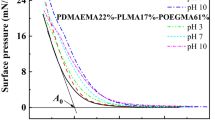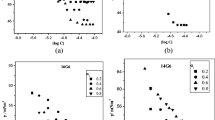Abstract
The aqueous mixed systems (EO76PO30EO76) (TBCP8400)—cetyltrimethyl ammonium tosylate (CTAT), and (EO97PO69EO97) (TBCP12600)—CTAT were studied to determine both the bulk aggregation and the adsorbed monolayer at the air/water interface. Results were interpreted with the pseudophase separation model plus the regular solution theory for aggregates and monolayers. The behavior is different for TBCP8400–CTAT and TBCP12600–CTAT mixtures, but it is strongly non-ideal in both cases. In bulk, TBCP8400–CTAT mixtures produce aggregates more close to CTAT micelles having TBCP8400 as a solubilizate than the inverse. At low CTAT content, the interaction is repulsive becoming attractive at high TBCP8400 content. The TBCP12600–CTAT aggregates strongly differ from the structure of both pure component micelles, and the interaction is always repulsive. In both cases, the interaction seems not to be cooperative but gradual. CTAT effect on copolymers aggregates seems to be more similar to that of a zwitterionic surfactant than to that of an ionic one. However, CTAT is not included in the aggregates as an ion pair, as revealed by the ionization degree results. It seems that cetyltrimethyl ammonium and tosylate ions have different effects on aggregates which in part are opposite. The adsorbed monolayers also show different behavior. In TBCP8400–CTAT system, the monolayer is mainly a CTAT one with inclusion of TBCP8400 as a monolayer-soluble impurity. However, the inclusion of the non-ionic surfactant alters the structure of the monolayer, which differs from that of the pure CTAT one. The area per adsorbed molecule (A0) is systematically higher than the ideal and computed ones. The system TBCP12600–CTAT shows a monolayer composition which is almost the same that the overall surfactant mixture composition, and the monolayer structure differs from both the pure-TBCP12600 and the pure-CTAT monolayers ones. The experimental A0 values are systematically lower than the ideal and the computed ones. Then, in both cases the A0 values for the pure components do not remain invariable in the mixed monolayer. The phenomenon is interpreted on the basis of the conformation of the copolymers adsorbed at the air/solution interface.












Similar content being viewed by others
References
Lindman B, Thalberg K (1993) In: Goddard E, Ananthapadmanabhan KP (eds) Interactions of surfactants with polymers and proteins. CRC Press, Boca Raton, p 203
Shiloach A, Blankschtein D (1998) Predicting micellar solution properties of binary surfactant mixtures. Langmuir 14:1618–1636
Barreiro-Iglesias R, Alvarez-Lorenzo C, Concheiro A (2003) Controlled release of estradiol solubilized in Carbopol/surfactant aggregates. J Controlled Rel 93:319–330
Goddard ED, Ananthapadmanabhan KP (1998) In: Kwak JCT (ed) Applications of polymer–surfactant systems. Surfactant science series, vol 77, chap 2. Marcel Dekker, New York
Li X, Wettig SD, Verrall RE (2005) Isothermal titration calorimetry and dynamic light scattering studies of interactions between gemini surfactants of different structure and pluronic block copolymers. J Colloid Interface Sci 282:466–477
Chaibundit C, Ricardo NMPS, Ricardo NMPS, O’Driscoll BMD, Hamley IW, Yeates SG, Booth C (2009) Aqueous gels of mixtures of ionic surfactant SDS with pluronic copolymers P123 or F127. Langmuir 25:13776–13783
Bakshi MS, Kaur N, Mahajan RK (2006) A comparative behavior of photophysical properties of Pluronic F127 and Triton X-100 with conventional zwitterionic and anionic surfactants. J Photochem Photobiol A Chem 183:146–153
Harris JM, Zalipsky S (1997) Poly(ethylene glycol): chemistry and biological applications. American Chemical Society, Washington, DC
Alexandridis P, Lindman B (eds) (2000) Amphiphilic block copolymers: self-assembly and applications. Elsevier, Amsterdam
Yang TF, Chen CN, Chen MC, Lai CH, Liang HF, Sung HW (2007) Shell-crosslinked Pluronic L121 micelles as a drug delivery vehicle. Biomaterials 28:725–734
Lee ES, Oh YT, Youn YS, Nam M, Park B, Yun J, Kim JH, Song HT, Oh KT (2011) Binary mixing of micelles using pluronics for a nano-sized drug delivery system. Colloid Surf B 82:190–195
Ivanova R, Alexandridis P, Lindman B (2001) Interaction of poloxamer block copolymers with cosolvents and surfactants. Colloid Surf A 183–185:41–53
Mortensen K (2001) PEO-related block copolymer surfactants. Colloids Surf A 183:277–292
Alexandridis P, Hatton TA (1995) Poly(ethylene oxide)–poly(propylene oxide)–poly(ethylene oxide) block copolymer surfactants in aqueous solutions and at interfaces: thermodynamics, structure, dynamics, and modeling. Colloids Surf A 96:1–46
Yang L, Alexandridis P, Steytler DC, Kositza MJ, Holzwarth JF (2000) Small-angle neutron scattering investigation of the temperature-dependent aggregation behavior of the block copolymer Pluronic L64 in aqueous solution. Langmuir 16:8555–8561
Fan L, Degen M, Grupido N, Bendle S, Pennartz P (2010) Effects of molecular weight, temperature and salt on the self assembly of triblock copolymer solutions. Mater Sci Eng A 528:127–136
Thurn T, Couderc S, Sidhu J, Bloor DM, Penfold J, Holzwarth JF, Wyn-Jones E (2002) Study of mixed micelles and interaction parameters for ABA triblock copolymers of the type EOm–POn–EOm and ionic surfactants: equilibrium and structure. Langmuir 18:9267–9275
Youssry M, Asaro F, Coppola L, Gentile L, Nicotera I (2010) Solution microstructures of the micellar phase of Pluronic L64/SDS/water system. J Colloid Interface Sci 342:348–353
Vieira JB, Thomas RK, Li ZX, Penfold J (2005) Unusual micelle and surface adsorption behavior in mixtures of surfactants with an ethylene oxide–propylene oxide triblock copolymer. Langmuir 21:4441–4451
Couderc S, Li Y, Bloor DM, Holzwarth JF, Wyn-Jones E (2001) Interaction between the nonionic surfactant hexaethylene glycol mono-n-dodecyl ether (C12EO6) and the surface active nonionic ABA block copolymer Pluronic F127 (EO97PO69EO97). Formation of mixed micelles studied using isothermal titration calorimetry and differential scanning calorimetry. Langmuir 17:4818–4824
Mahajan RK, Kaur K, Bakshi MS (2005) Cyclic voltammetry investigation of the mixed micelles of cationic surfactants with Pluronic F68 and Triton X-100. Colloid Surf A 255:33–39
Mahajan RK, Kaur N, Bakshi MS (2006) Cyclic voltammetry investigation of the mixed micelles of conventional surfactants with L64 and F127. Colloid Surf A 276:221–227
Singh PK, Kumbhakar M, Ganguly R, Aswal VK, Pal H, Nath S (2010) Time-resolved fluorescence and small angle neutron scattering study in pluronics-surfactant supramolecular assemblies. J Phys Chem B 114:3818–3826
Li Y, Xu R, Couder S, Bloor DM, Holzwarth JF, Wyn-Jones E (2001) Binding of tetradecyltrimethylammonium bromide to the ABA block copolymer Pluronic F127 (EO97PO69EO97): electromotive force, microcalorimetry, and light scattering studies. Langmuir 17:5742–5747
Truong MT, Walker LM (2000) Controlling the shear-induced structural transition of rodlike micelles using nonionic polymer. Langmuir 16:7991–7998
Mata J, Varade D, Bahadur P (2005) Aggregation behavior of quaternary salt based cationic surfactants. Thermochim Acta 428:147–155
Müller AJ, Torres MF, Sáez AE (2004) Effect of the flow field on the rheological behavior of aqueous cetyltrimethylammonium p-toluenesulfonate solutions. Langmuir 20:3838–3841
Schubert BA, Kaler EW, Wagner NJ (2003) The microstructure and rheology of mixed cationic/anionic wormlike micelles. Langmuir 19:4079–4089
Rojas MR, Müller AJ, Sáez AE (2008) Shear rheology and porous media flow of wormlike micelle solutions formed by mixtures of surfactants of opposite charge. J Colloid Interface Sci 326:221–226
Hecht E, Mortensen K, Gradzielski M, Hoffmann H (1995) Interaction of ABA block copolymers with ionic surfactants: influence on micellization and gelation. J Phys Chem 99:4866–4874
Almgren M, van Stam J, Lindblad C, Li P, Stilbs P, Bahadur P (1991) Aggregation of poly(ethylene oxide)–poly(propylene oxide)–poly(ethylene oxide) triblock copolymers in the presence of sodium dodecyl sulfate in aqueous solution. J Phys Chem 95:5677–5684
Hecht E, Hofman H (1994) Interaction of ABA block copolymers with ionic surfactants in aqueous solution. Langmuir 10:86–91
Soltero JFA, Puig JE, Manero O, Schulz PC (1995) Rheology of cetyltrimethylammonium tosylate—water system. 1. Relation to phase behavior. Langmuir 11:3337–3346
Miura M, Kodama M (1972) The second CMC of the aqueous solution of sodium dodecyl sulfate. I. Conductivity. Bull Chem Soc Jpn 45:428–431
Rubingh DN (1979) In: Mittal KL (eds) Solution chemistry of surfactants, vol 1. Plenum Press, New York, p 337
Proverbio ZE, Schulz PC, Puig JE (2002) Aggregation of the aqueous dodecyltrimethylammonium bromide–didodecyldimethylammonium bromide system at low concentration. Colloid Polym Sci 280:1045–1052
Moya SE, Schulz PC (1999) The aggregation of the sodium dodecylsulfate–n-octanol–water system at low concentration. Colloid Polym Sci 277(8):735–742
Holland PM, Rubingh DN (eds) (1992) Mixed surfactant systems, ACS symposium series 501. ACS, Washington, DC
Gamboa C, Rios H, Sanchez V (1994) Surfactant aggregation in formamide. Langmuir 10:2025–2027
Mata J, Varade D, Bahadur P (2005) Aggregation behavior of quaternary salt based cationic surfactants. Thermochim Acta 428:147–155
Gamboa IC, Rios H, Barraza R, Sanhueza P (1992) Behavior of low-solubility detergents. J Colloid Interface Sci 152(1):230–236
Batrakova EV, Han H-Y, Alakhov VY, Miller DW, Kabanov AV (1998) Effects of pluronic block copolymers on drug absorption in Caco-2 cell monolayers. Pharm Res 15:850–855
Nakashima K, Anzai T, Fujimoto Y (1994) Fluorescence studies on the properties of a Pluronic F68 micelle. Langmuir 10:658–661
Lopes JR, Loh W (1998) Investigation of self-assembly and micelle polarity for a wide range of ethylene oxide-propylene oxide-ethylene oxide block copolymers in water. Langmuir 14:750–756
Hvidt S (1995) Pressure- and temperature-dependent micellisation of a poly(ethylene oxide)–poly(propylene oxide) triblock copolymer in aqueous solution. Colloids Surf A 112:201–207
Goldmints I, Yu G-E, Booth C, Smith KA, Hatton TA (1999) Structure of (deuterated PEO)-(PPO)-(deuterated PEO) block copolymer micelles as determined by small angle neutron scattering. Langmuir 15:1651–1656
Almgren M, Brown W, Hvidt S (1995) Self-aggregation and phase behavior of poly(ethylene oxide)–poly(propylene oxide)–block–poly(ethylene oxide) copolymers in aqueous solution. Colloid Polym Sci 273:2–15
Gamboa C, Olea A, Rios H, Henriquez M (1992) Association of alcohol with cationic micelles. Langmuir 8:23–26
Sierra MB, Morini MA, Schulz PC (2004) The catanionic system sodium undecenoate-dodecyltrimethylammonium bromide at low concentration. Colloid Polym Sci 282(6):633–641
Nagarajan R, Ganesh K (1996) Comparison of solubilization of hydrocarbons in (PEO–PPO) diblock versus (PEO–PPO–PEO) triblock copolymer micelles. J Colloid Interface Sci 184:489–499
Hecht E, Hoffmann H (1995) Kinetic and calorimetric investigations on micelle formation of block copolymers of the poloxamer type. Colloid Surf A 96:181–197
Chang LC, Lin C-Y, Kuo M-W, Gau C-S (2005) Interactions of pluronics with phospholipids monolayers at the air–water interface. J Colloid Interface Sci 285:640–652
Cooke DJ, Blondel JAK, Lu J, Thomas RK (1998) Interaction between poly(ethylene oxide) and monovalent dodecyl sulfates studied by neutron reflection. Langmuir 14:1990–1995
Li ZX, Bain CD, Thomas RK, Duffy DC, Penfold J (1998) Monolayers of hexadecyltrimethylammonium p-tosylate at the air–water interface. 2. Neutron reflection. J Phys Chem B 102:9473–9480
Sedev R, Exerowa D, Findenegg GH (2000) Poly(ethylene oxide)–poly(propylene oxide)–poly(ethylene oxide) triblock copolymers at the water/air interface and in foam films. Colloid Polym Sci 278:119–123
Vieira JB, Li ZX, Thomas RK, Penfold J (2002) Structure of triblock copolymers of ethylene oxide and propylene oxide at the air/water interface determined by neutron reflection. J Phys Chem B 106:10641–10648
Muñoz MG, Monroy F, Ortega F, Rubio RG, Langevin D (2000) Monolayers of symmetric triblock copolymers at the air–water interface. 1. Equilibrium properties. Langmuir 16:1083–1093
Yang Z, Sharma R (2001) Dynamics of PEO–PPO–PEO and PPO–PEO–PPO triblock copolymers at the air/water interface upon thermal stimulation. Langmuir 17:6254–6261
Alexandridis P, Athanassiou V, Fukuda S, Hatton TA (1994) Surface activity of poly(ethylene oxide)–poly(propylene oxide)–block–poly(ethylene oxide) copolymers. Langmuir 10:2604–2612
Bell GR, Li ZX, Bain CD, Fischer P, Duffy DC (1998) Monolayers of hexadecyltrimethylammonium p-tosylate at the air–water interface. 1. Sum frequency spectroscopy. J Phys Chem B 102:9461–9472
Acknowledgments
This work was financed by a grant of the Universidad Nacional del Sur, and other from the Agencia Nacional de Promoción de Ciencia y Técnica (ANPCyT). MB has a fellowship of the Consejo Nacional de Investigaciones Científicas y Técnicas (CONICET).
Author information
Authors and Affiliations
Corresponding author
Electronic supplementary material
Below is the link to the electronic supplementary material.
About this article
Cite this article
Brigante, M., Schulz, P.C. Aggregation and Adsorption at the Air–Solution Interface of the Cetyltrimethyl Ammonium Tosylate With Two Poly(oxyethylene)–Poly(oxypropylene)–Poly(oxyethylene) Block Copolymers Aqueous Mixtures. J Surfact Deterg 14, 439–453 (2011). https://doi.org/10.1007/s11743-011-1264-5
Received:
Accepted:
Published:
Issue Date:
DOI: https://doi.org/10.1007/s11743-011-1264-5




